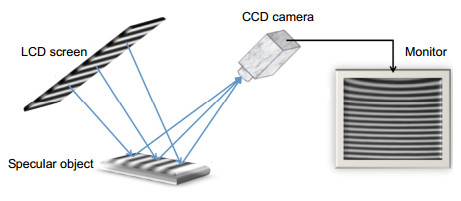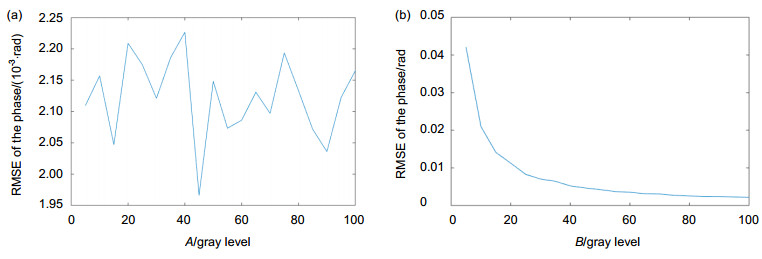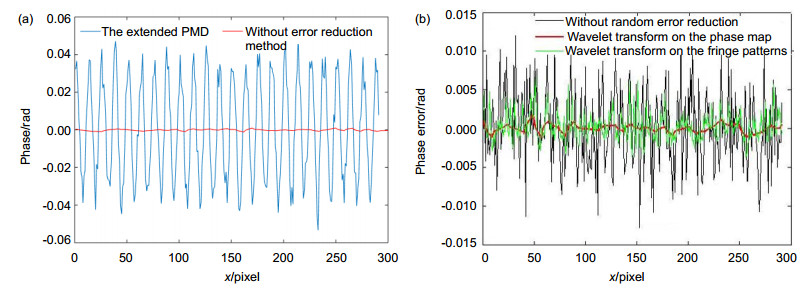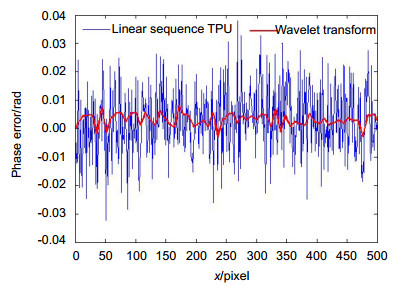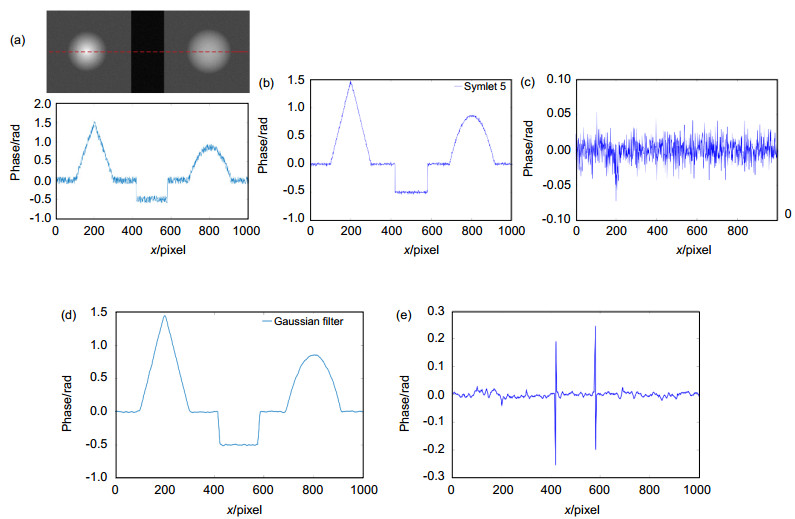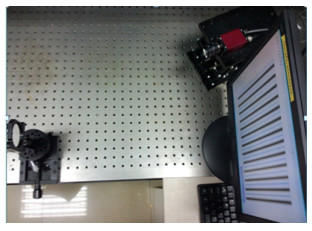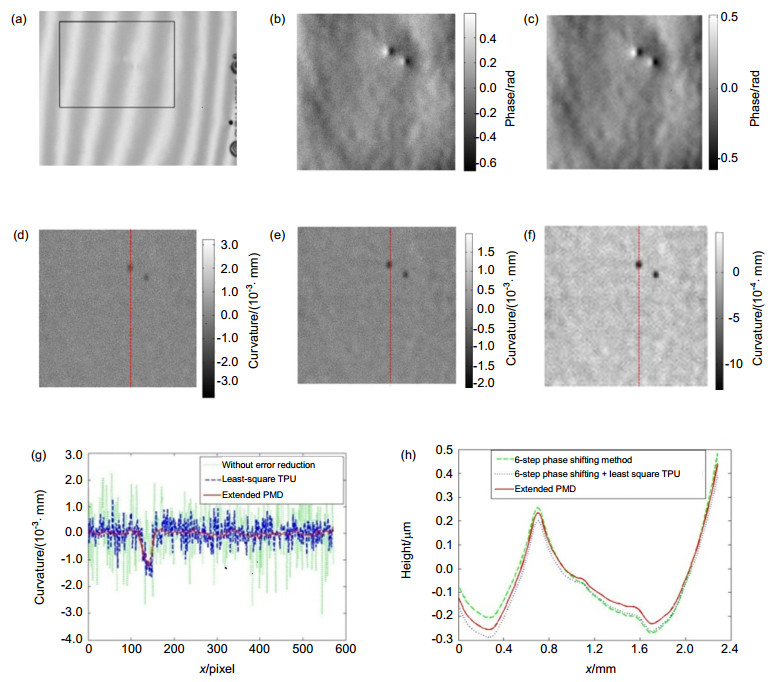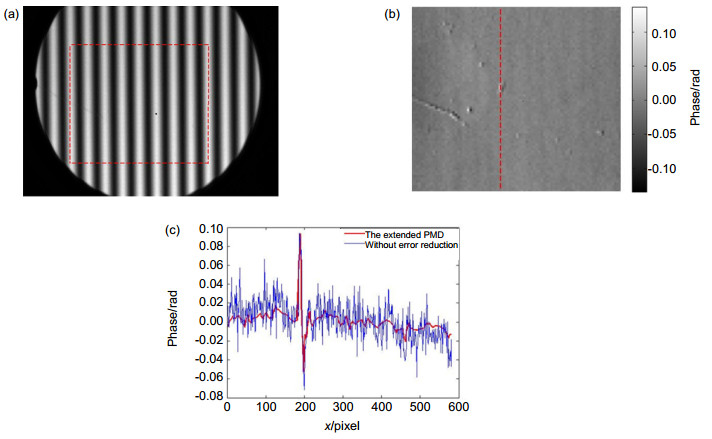High-precision measurement of low reflectivity specular object based on phase measuring deflectometry
-
Abstract:
Phase measuring deflectometry (PMD) is a robust, noncoherent technique for the characterization of specular surface. For measuring high specular reflectivity surface, PMD can deliver micron radian range local gradient. However, when the measured surface has low specular reflectivity, the accuracy of the measured gradient is low since the captured fringe pattern shows low signal to noise ratio. The phase error characteristics in PMD system when testing low reflectivity surfaces are analyzed. The analysis illustrates that the random phase error increases rapidly while the nonlinear error drops slowly with the decreasing of the tested surface reflectivity. In order to attain high precision measurement of low reflectivity specular surface, a robust error reduction method based on wavelet de-noising is proposed to reduce the phase error. This error reduction method is compared with several other normally used methods in both simulation and experiment work. The method based on the wavelet de-noising shows better performance when measuring the low reflectivity specular surface.

-

The phase measuring deflectometry (PMD) has attracted extensive attention to researchers in recent years as it has the advantage of being fast, non-coherent and high sensitivity. The high sensitivity of PMD allows measuring gradient changes in the range of micro-scale and local height changes in the range of nanometers, which enables PMD as an effective tool for high precision inspection of defects or local height variation. The accuracy of the PMD is related to the phase reliability of the captured fringe pattern. Errors in the phase map influence the accuracy of the whole measurement. When testing low reflectivity specular surfaces like cell phone shell, contrast of the distorted fringe patterns is low, and there are always relatively big errors in the phase map. The phase error characteristics in PMD system when testing low reflectivity surfaces are analyzed. The results illustrate that the random phase error increases rapidly while the nonlinear error drops slowly with the decreasing of the tested surface reflectivity. In order to attain high precision measurement of low reflectivity specular surface, a robust error reduction method based on wavelet de-noising is presented to reduce the phase error. The optimal wavelet parameters for denoising the aimed noise level are carried out by simulation, which are 5 decomposition level, ‘soft’ thresholding and ‘rigrsure’ thresholding rule. The error reduction method is compared with the least-square TPU method and low-pass Gaussian filter method. As the result, when compared to the least-square TPU method, the method based on wavelet de-noising needs much less shooting time and has a more outstanding error reduction effect. In comparison with the low-pass Gaussian filter method, the wavelet de-noising method performs better in the preservation of phase details. The experiment of measuring a typical mobile shell shows clearly the superiority of the method based on the wavelet de-noising. In some situations, if the curvature maps are required for the inspection of defects, especially when the tested surfaces have low reflectivity, the method based on wavelet de-noising would be quite suitable for error reduction. The method based on wavelet de-noising is also suitable to detect small defects and for the measurement of the high reflective surface to reach higher precision. In the experiment of measuring a plane mirror, the RMS phase error with the method based on wavelet de-noising is 5 times smaller than that with only 6-step phase shifting method.
-

-
Figure 1. Comparison of the fringe patterns of low and high reflectivity surfaces. (a) The distorted fringe pattern of a low reflectivity surface. (b) The wrapped phase map of the low reflectivity surface. (c) Middle row of (a). (d) The distorted fringe pattern of a high reflectivity surface. (e) The wrapped phase map of the high reflectivity surface. (f) Middle row of (d).
Figure 7. The simulation results of the wavelet parameter selection and low-pass Gaussian filter de-noising. (a) The noisy phase. (b) The data of red line in (a) after the process of Symlet 5 wavelet de-noising. (c) The residual error of wavelet de-noising. (d) The data of red line after a low-pass Gaussian filter. (e) The residual error of Gaussian filter de-noising.
Figure 9. The experimental results of the mobile shell. (a) The tested mobile shell. (b), (c) The x-direction phase distribution without error reduction and with the method based on wavelet de-noisings(extended PMD). (d)~(f) The curvature distribution without error reduction, with least-square TPU method, and with the method described in the manuscript, respectively. (g) The data of red lines in (d)~(f). (h) The lines of the reconstructed height distribution with no error reduction, with least-square TPU method, and with the method described in the manuscript, respectively
-
[1] Knauer M C, Kaminski J, Hausler G. Phase measuring deflectometry: a new approach to measure specular free-form surfaces[J]. Proceedings of SPIE, 2004, 5457: 366-376. doi: 10.1117/12.545704
[2] Song Lei, Yue Huimin, Kim H, et al. A study on carrier phase distortion in phase measuring deflectometry with non-telecentric imaging[J]. Optics Express, 2012, 20(22): 24505-24515. doi: 10.1364/OE.20.024505
[3] Yue Huimin, Wu Yuxiang, Zhao Biyu, et al. A carrier removal method in phase measuring deflectometry based on the analytical carrier phase description[J]. Optics Express, 2013, 21(19): 21756-21765. doi: 10.1364/OE.21.021756
[4] Jüptner W, Bothe T. Sub-nanometer resolution for the inspection of reflective surfaces using white light[J]. Proceedings of SPIE, 2009, 7405: 740502. doi: 10.1117/12.838373
[5] Bothe T, Li Wansong, von Kopylow C, et al. High-resolution 3D shape measurement on specular surfaces by fringe reflection[J]. Proceedings of SPIE, 2004, 5457: 411-422. doi: 10.1117/12.545987
[6] Skydan O A, Lalor M J, Burton D R. 3D shape measurement of automotive glass by using a fringe reflection technique[J]. Measurement Science and Technology, 2006, 18(1): 106-114. http://www.ingentaconnect.com/content/iop/mst/2007/00000018/00000001/art00013
[7] Zhang Song, Van Der Weide D, Oliver J. Superfast phase-shifting method for 3-D shape measurement[J]. Optics Express, 2010, 18(9): 9684-9689. doi: 10.1364/OE.18.009684
[8] Zhang Qican, Wu Zhiyun. A carrier removal method in Fourier transform profilometry with Zernike polynomials[J]. Optics and Lasers in Engineering, 2013, 51(3): 253-260. https://www.sciencedirect.com/science/article/pii/S014381661200293X
[9] Notni G H, Notni G. Digital fringe projection in 3D shape measurement: an error analysis[J]. Proceedings of SPIE, 2003, 5144: 372-380. doi: 10.1117/12.500618
[10] Liu Yong, Huang Dingfa, Jiang Yong. Flexible error-reduction method for shape measurement by temporal phase unwrapping: phase averaging method[J]. Applied Optics, 2012, 51(21): 4945-4953. doi: 10.1364/AO.51.004945
[11] Pan Bing, Kemao Qian, Huang Lei, et al. Phase error analysis and compensation for nonsinusoidal waveforms in phase-shifting digital fringe projection profilometry[J]. Optics Letters, 2009, 34(4): 416-418. doi: 10.1364/OL.34.000416
[12] Hoang T, Pan Bing, Nguyen D, et al. Generic gamma correction for accuracy enhancement in fringe-projection profilometry[J]. Optics Letters, 2010, 35(12): 1992-1994. doi: 10.1364/OL.35.001992
[13] Xiao Kaida, Fu Chenyang, Karatzas D, et al. Visual gamma correction for LCD displays[J]. Displays, 2011, 32(1): 17-23. doi: 10.1016/j.displa.2010.09.003
[14] Healey G E, Kondepudy R. Radiometric CCD camera calibration and noise estimation[J]. IEEE Transactions on Pattern Analysis and Machine Intelligence, 1994, 16(3): 267-276. doi: 10.1109/34.276126
[15] Faraji H, MacLean W J. CCD noise removal in digital images[J]. IEEE Transactions on Image Processing, 2006, 15(9): 2676-2685. doi: 10.1109/TIP.2006.877363
[16] Wu Yuxiang, Yue Huimin, Ji Jingya, et al. Dynamic specular surface measurement based on color-encoded fringe reflection technique[J]. Optical Engineering, 2016, 55(2): 024104. doi: 10.1117/1.OE.55.2.024104
[17] Schmit J, Creath K. Extended averaging technique for derivation of error-compensating algorithms in phase-shifting interferometry[J]. Appllied Optics, 1995, 34(19): 3610-3619. doi: 10.1364/AO.34.003610
[18] Huntley J M, Saldner H O. Error-reduction methods for shape measurement by temporal phase unwrapping[J]. Journal of the Optical Society of America A, 1997, 14(12): 3188-3196. doi: 10.1364/JOSAA.14.003188
[19] Ma Jun, Wang Zhaoyang, Vo M, et al. Wavelet selection in two-dimensional continuous wavelet transform technique for optical fringe pattern analysis[J]. Journal of Optics, 2012, 14(6): 065403. doi: 10.1088/2040-8978/14/6/065403
[20] Huang Lei, Kemao Qian, Pan Bing, et al. Comparison of Fourier transform, windowed Fourier transform, and wavelet transform methods for phase extraction from a single fringe pattern in fringe projection profilometry[J]. Optics and Lasers in Engineering, 2010, 48(2): 141-148. doi: 10.1016/j.optlaseng.2009.04.003
[21] Zhang Zibang, Zhong Jingang. Applicability analysis of wave-let-transform profilometry[J]. Optics Express, 2013, 21(16): 18777-18796. doi: 10.1364/OE.21.018777
[22] Chang S G, Yu Bin, Vetterli M. Adaptive wavelet thresholding for image denoising and compression[J]. IEEE Transactions on Image Processing, 2000, 9(9): 1532-1546. doi: 10.1109/83.862633
[23] Nowak R D. Wavelet-based Rician noise removal for magnetic resonance imaging[J]. IEEE Transactions on Image Processing, 1999, 8(10): 1408-1419. doi: 10.1109/83.791966
[24] Chen Yichun, Lin P C, Lee C M, et al. Iterative phase-shifting algorithm immune to random phase shifts and tilts[J]. Applied Optics, 2013, 52(14): 3381-3386. doi: 10.1364/AO.52.003381
[25] Messer S R, Agzarian J, Abbott D. Optimal wavelet denoising for phonocardiograms[J]. Microelectronics Journal, 2001, 32(12): 931-941. doi: 10.1016/S0026-2692(01)00095-7
-


 E-mail Alert
E-mail Alert RSS
RSS
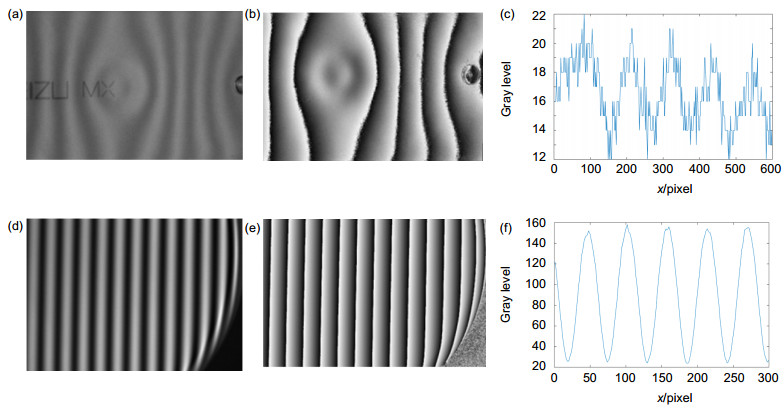
 下载:
下载:
